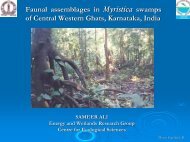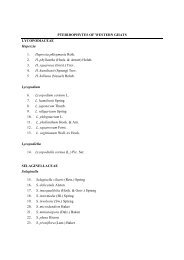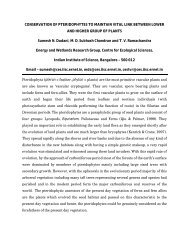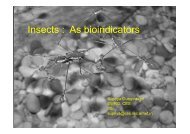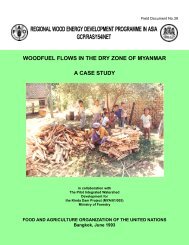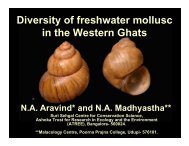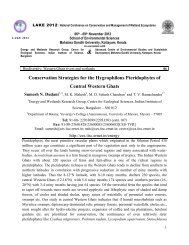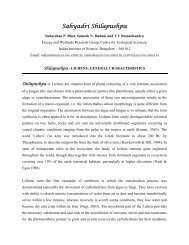EFFECTIVE ROLE OF MICROORGANISM AND SEAWEEDS AS ...
EFFECTIVE ROLE OF MICROORGANISM AND SEAWEEDS AS ...
EFFECTIVE ROLE OF MICROORGANISM AND SEAWEEDS AS ...
You also want an ePaper? Increase the reach of your titles
YUMPU automatically turns print PDFs into web optimized ePapers that Google loves.
<strong>EFFECTIVE</strong> <strong>ROLE</strong> <strong>OF</strong> <strong>MICROORGANISM</strong> <strong>AND</strong> <strong>SEAWEEDS</strong> <strong>AS</strong> BI<strong>OF</strong>ERTILIZERS IN<br />
ORGANIC FARMING FOR A SUSTAINABLE ENVIRONMENT<br />
SUB-HEADING – USE <strong>OF</strong> BI<strong>OF</strong>ERTILIZERS <strong>AS</strong> ORGANIC FERTILIZERS<br />
ABSTRACT<br />
S.B. Padhi and P.K. Swain<br />
Algal Research Laboratory,<br />
Department of Botany<br />
Berhampur University<br />
India is an agricultural country. Nearly 70% of the population thrive in rural areas, engaged in<br />
agriculture making the backbone of our economy. To meet the tremendous prenure in food production<br />
in the country, chemical fertilizers are used to enhance the crop production. However, chemical<br />
fertilizes and chemical pesticides changed the agriculture scenario in the world.<br />
Microbes play a vital role as organic fertilizers in facilitating uptake of nutrients in a crop.<br />
Rhizobia and blue-green algae fix atmospheric nitrogen and reduce dependency upon artificial<br />
application of chemical fertilizers. Seaweeds are one of the most important marine resources of the<br />
world. Liquid fertilizers derived from seaweeds are found to be superior to chemical fertilizers.<br />
Pollution of the environment has become a major concentration of society. Increasingly the<br />
movement away from organic methods of farming has resulted in the loss of food, nutritional<br />
livelihood and ecological security and at time, life itself.<br />
In this circumstances, India needs a second green revolution based on environmentally safe<br />
technology. Application of biofertilizers as a component of organic cultivation is an exciting area for<br />
enhanced crop production and suggested as an alternative control measure for mitigation of<br />
environmental pollution.<br />
ORGANIC FARMING<br />
Chemical Fertilizers<br />
Two-thirds of the Third World population depends on agriculture for in livelihood. Farming is<br />
both away of life and the principal means of livelihood to 65 per cent of India’s population of 110<br />
crore. Use of chemical fertilizer and chemical pesticides changed the agriculture scenario in the world.<br />
Irresponsible methods of cultivation and increased use of quick release chemical fertilizers, over<br />
irrigation rendered the soil unfit for cultivation. Higher application of chemical fertilizers results in<br />
higher imparts, higher cost of production, transportation and overheads. It results in erosion of local<br />
resources and poverty.<br />
Organic fertilizers<br />
Microbes play a vital role in facilitating uptake of nutrients in a crop. Rhizobia, among several<br />
of these microbes are quite popular for leguminous crops. Microbial inoculation involves the selection<br />
and multiplication of plant beneficial micro-organisms and applying them to plants, seed or soil. The<br />
main use of micro-organisms are as biofertilizers for improved plant nutrition and as a biological<br />
control agents to combat pests, weeds and diseases. Microbial inoculation of plants is of great<br />
importance in less intensive low-input agricultural systems in developing countries (Davison, 1988).<br />
Biological nitrogen fixation<br />
Biological nitrogen fixation holds much promise for developing countries. Nitrogen fixation is<br />
found only in prokaryotic organisms, bacteria and blue-green algae. Rhizobia among several of these<br />
microbes are quite popular for leguminous crops. Inoculants for soyabean account for a very large<br />
proportion of biological nitrogen fixation. Inoculants for forage, pasture and food legumes are also<br />
produced in developing countries. Inoculants use has its main impact on large scale producers<br />
(Eaglesham, 1989). Rhizobium inoculation is considered a key component of in the improvement of<br />
pasture legume production in South America, West Asia and North Africa and it may prove beneficial<br />
elsewhere (Eaglesham, 1989). Pseudomonas and several other bacteria facilitate nutrient uptake and<br />
form a very friendly network around the roots. Symbiotic organisms form a harmonious environment in<br />
the soils, more abundantly in the tropical climates. It empowers the local community to use its own<br />
resources in terms of biodiversity resources and rights, saves on application of high cost fertilizers,<br />
renders the soil health and avoids interference with the environment.<br />
Biologically active compounds may be liberated from blue-green algae growing on the surface<br />
of moist soils. Such compounds may also be released exudates from algae grown in liquid culture. The<br />
blue-green algae (Cyanobacteria) are another source of biological nitrogen. They are distributed in<br />
symbiosis with the water fern Azolla. Cyanobacteria are structurally diverse assemblages of aerobic
gram-negative eubacteria (Prokaryotes) characterized by their ability to form oxygenic photosynthesis.<br />
They reduce molecular atmospheric nitrogen to ammonium which can then be utilized for amino acid<br />
and protein biosyntheis. Nitrogen compounds which can be assimilated by other plants are ultimately<br />
released to the soil after death of the algal cells and subsequent mineralization and nitrification. Algal<br />
nitrogen fixation release the fixed nitrogen and its assimilation by higher plants may be rapid (Stewart,<br />
1967). The algal extracts of Westiellopsis prolifica analysed by Fogg and Pattnaik (1966) showed that<br />
ammonium and amide-nitrogen accounted for most of the total extracellular combined nitrogen.<br />
Pretreatment of seeds of vegetable crop with extract of Westiellopsis prolifica promoted germination<br />
and the subsequent growth of development.<br />
Mycorrhizal associations<br />
Mycorrhizal associations (symbioses between certain fungi and the roots of vascular plants)<br />
can increase the rate of uptake of nutrients such as nitrogen and phosphorous from deficient soils. The<br />
production of mycorrhizal inocula may well be possible.<br />
Seaweed biofertilizer<br />
Seaweeds are one of the most important marine resources of the world. Seaweed extracts have<br />
been marketed for several years as fertilizer additives and beneficial results from their use have been<br />
reported (Booth, 1965). The possibilities of using seaweed in modern agriculture has been investigated<br />
by many (Thivy, 1961; Aitken and Sen 1965; Boney, 1965). Different forms of seaweed preparation<br />
such as LSF (Liquid Seaweed Fertilizers), SLF(Seaweed Liquid Fertilizers), LF (Liquid Fertilizers),<br />
and either whole or finally chopped powered algal manure have been used and all of them have been<br />
reported to produce beneficial effects on cereals, pulses and flowering plants. Seaweed manures have<br />
the advantage of being free from weeds and pathogenic fungi. Liquid extracts of brown algae are being<br />
sold as biostimulants or biofertilizers in various brand names. Promising increased crop yield, nutrient<br />
uptake, resistance to frost and stress, improved seed germination of reduced incidence of fungal and<br />
inspect attack have been resulted by application of SLF. Seaweeds are known to contain appreciable<br />
quantities of plant growth regulators (Mooney and Van Staden, 1985), Cytokinin (Smith and<br />
Vanstaden, 1984), IAA (Abe, H. et al., 1972), gibberllins and gibberllin like substance (Bentley, 1960;<br />
Radley, 1961; Sekar et al., 1995). Hence marine algae, particularly seaweeds have a vital role to play in<br />
agriculture, especially in the third world country where irrational use of chemical fertilizer and<br />
pesticides is a cause of concern. Extensive regional tribals would need to be conducted with the product<br />
to determine the environmental limits on biological activity and monitor the survival and dispersal of<br />
the inocula (Davison, 1988). Hence use of modern agriculture in conjunction with traditional farming<br />
practices is the sustainable solution for the future.<br />
References<br />
Abe, H, Vchiyams, M. and Sato, R., 1972. Isolation and identification of nature action in marine algae.<br />
Agro. Biol. Chem. 36:2259-2260.<br />
Aitken, J.E. and Senn, J.L. 1965. Seaweed products as fertilizer and sal conditions. Bot. Mar. 8:144-<br />
148.<br />
B. Nanda, S.K. Tripathy and S. Padhi, 1991. Effect of algalization on seed germination of vegetable<br />
crops. World Journal of microbiology and biotechnology 7:622-623.<br />
Bentley, J.A. 1960. Plant hormones in marine phytoplankton, zooplankton and seawater. J. Mar. Biol.<br />
Ass. U.K., 39:433-444.<br />
Boney, A.D. 1965. A biology of marine algae. Hutchinson on Educational Ltd., London.<br />
Booth, E. 1965. The manorial value of seaweed. Bot. Mar. 8:138-143.<br />
Davison, J. 1988. Plant beneficial bacteria. Biotechnology, 6 March, 1988, 282-286.<br />
Fogg, G.E. and Pattnaik, H. 1966. The release of extracellular nitrogenous products by Westiellopsis<br />
prolifica janet. Phykos, 5:58-67.<br />
Mooney, P.A. and Van Staden, J. 1985. Effect of seaweed concentrate on the growth of wheat under<br />
condition of water fern. S. Afr. J. Sci. 8:632-633.<br />
Radley, M. 1961. Gibberllin-like substances in plants. Nature, London 191:684-685.<br />
Sekar, R. Thangaraju, N. and Rangasamy, R. 1995. Effect of seaweed liquid fertilizer from Ulva<br />
lactuca L. on vigna Unguiculata L. (Walp) Phykos. 34:49-53.<br />
Smith, F.B.C. and Van staden, J. 1984. The effect of seaweed concentrate and fertilizer on growth and<br />
endogenous Cytokinin content of Phaseolus vulsaris. South African journal of Botany, 3:375-379.<br />
Stewart, W.D.P. 1967. Transfer of biologically fixed nitrogen in a sand dune slack region. Nature 214,<br />
603-604.<br />
Thivy, F. 1961. Seaweed manure for perfect sal and smiling fields. Salt. Res. Indust. 1:1-4
PERSONNEL INFORMATION<br />
NAME <strong>AND</strong> ADDRESS<br />
Prof. S.B. Padhi<br />
Professor of Botany<br />
(Coordinator Biotechnology)<br />
Algal Research Laboratory<br />
Department of Botany<br />
Berhampur University<br />
Telephone Numbers : 9337503243<br />
0680-2292182<br />
E-mail: sailabala_padhi@gmail.com<br />
Name : Prof. (Mrs.) S.B. Padhi<br />
Date of Birth: 7 th June 1950<br />
Institution : Algal Research Laboratory<br />
Department of Botany<br />
Berhampur University<br />
Pin-760 007<br />
Academic and professional profile (M.Sc. onwards)<br />
Sl. No. Degree Name Name of the<br />
institution<br />
1 M.Sc. Berhampur<br />
University<br />
2. M.Phil. Berhampur<br />
University<br />
3 Ph.D. Berhampur<br />
University<br />
4. D.Sc. Berhampur<br />
University<br />
List of publication -63<br />
Completed research project -4<br />
Foreign country visited – USA, Canada, Bangladesh<br />
International / National conference attended - 30<br />
M.Phil. awarded – 35<br />
Ph.D. awarded -20<br />
D.Sc. Awarded - 1<br />
Rank and year<br />
place of award<br />
1978<br />
1983<br />
1993<br />
Specialisation<br />
Algology (Fresh<br />
water and Marine<br />
algae)<br />
Prof. (Mrs.) S.B. Padhi



